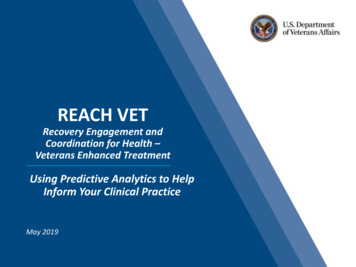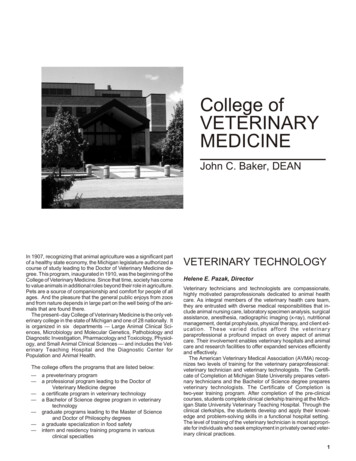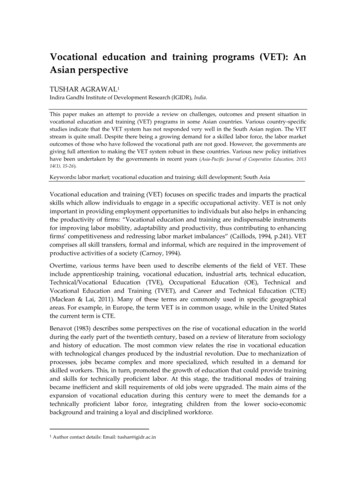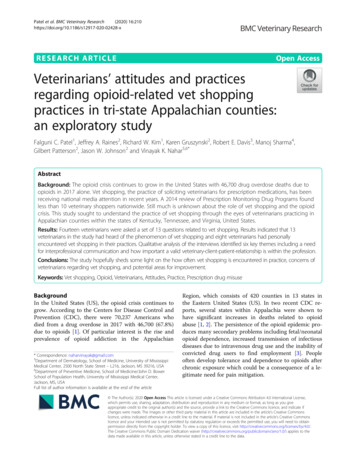
Transcription
REACH VETRecovery Engagement andCoordination for Health –Veterans Enhanced TreatmentUsing Predictive Analytics to HelpInform Your Clinical PracticeMay 2019
Objectives Overview of REACH VET REACH VET as a Clinical Tool REACH VET in Clinical Practice REACH VET and Additional Tools2
REACH VET Overview3
REACH VET is Based on the finding that although suicide rates in VHA patients havedecreased relative to the US adult population as a whole, they remainhigh Supported by senior VA leadership as part of establishing suicideprevention as a major priority Goes beyond intercepting people on the trajectory towards suicide Uses predictive models to identify Veterans whose care should beenhanced Supplements current clinical strategies to identify at-risk Veterans Complements other VHA initiatives designed to identify newopportunities to enhance care for Veterans4
Initial Effectiveness Evaluation February 2018: One year of implementation Initial implementation findings: Examined six-month outcomes for patients identified March – May2017 In comparison to the control groups, patients exhibited: More health care appointments More mental health appointments Decreases in the percent of missed appointments Greater completion of suicide prevention safety plans Less all-cause mortality Overall, early findings on implementation and outcomes arepositive5
REACH VET Statistical Model The REACH VET model includes over 60 factors that provide a snapshotof Veterans and their service utilization over the past 2 years It is the combination and interaction of all these factors, when takentogether, that are used to identify Veterans for the REACH VET program Currently being updated to include updated model factors to bereleased in the near future
Model Predictors Demographics (e.g., age 80, male, married) Prior suicide attempts Diagnoses (e.g., depression, diabetes, homelessness) VHA service utilization (e.g., emergency department visit, psychiatricdischarge) Medications (e.g., antipsychotics, opioids, statins) Interactions (e.g., anxiety disorder x personality disorder, widowed xmale)McCarthy et al., 20157
Variables Included in the REACH VET ModelDemographicsAge 80MaleCurrently marriedRegion (West)Race/ethnicity (White)(Non-white)Service Connected (SC) Disability StatusSC 30%SC 70%Prior Suicide AttemptsAny suicide attempt in prior 1 monthin prior 6 monthsin prior 18 monthsDiagnosesArthritis (prior 12 months)(prior 24 months)Bipolar I (prior 24 months)Head and neck cancer (prior 12 months)(prior 24 months)Chronic pain (prior 24 months)Depression (prior 12 months)(prior 24 months)Diabetes mellitus (prior 12 months)Systemic lupus erythematosus (prior 24months)Substance Use Disorder (prior 24months)Homelessness or services (prior 24months)VHA utilizationEmergency Dept visit (prior month)(prior 2 months)Psychiatric Discharge (prior month)(prior 6 months)(prior 12 months)(prior 24 months)Any mental health (MH) tx (prior 12 months)(prior 24 months)Days of Use (0-30) in the 13th month priorin the 7th month priorEmergency Dept visits (prior month)(prior 24 months)First Use in Prior 5 Years was in the Prior YearDays of Inpatient MH (0-30) in 7th month priorSquaredDays of Outpatient (0-30) in 7th month priorin 8th month priorin 15th month priorin 23rd month priorDays with outpt MH use in prior month, squareMedicationsAlprazolam (prior 24 months)Antidepressant (prior 24 months)Antipsychotic (prior 12 months)Clonazepam (prior 12 months)(prior 24 months)Lorazepam (prior 12 months)Mirtazapine (prior 12 months)(prior 24 months)Mood stabilizers (prior 12 months)Opioids (prior 12 months)Sedatives or anxiolytics (prior 12 months)(prior 24 months)Statins (prior 12 months)Zolpidem (prior 24 months)InteractionsBetween Other anxiety disorder (prior 24 months)and Personality disorder (prior 24 months)Interaction between Divorced and MaleInteraction between Widowed and MaleVHA users: With VHA outpatient or inpatientencounters in prior 24 monthsPrior 24 months8Prior 12 monthsDate ofassessment
REACH VET: At-Risk for Medical and MentalHealth Outcomes Suicide and suicide attempts Non-suicide external-cause mortality Accidents, injuries, overdoses,violence Non-suicide all-cause mortality Mental health hospitalization Medical/surgical/rehabilitationhospitalizationNot all identified Veterans will havereported or experienced suicidal ideation orbehavior. Of those in the top .1%, only 30%were identified as high risk for suicidebased on clinical signs and symptoms.9
Background: The Predictive Model Developed by VA and NIMH researchersIncludes clinical and administrative data for eachVeteran who utilizes VHA health care servicesCalculated Risk10
Background: The Predictive Model Other adverse outcomesOutcomeTop .1%Top RiskOther external-cause mortality8.8 x*As compared to overall VHA populationOther all-cause mortality1.3 xMental health inpatient bed stays66 xMedical/surgical/rehab inpatient bed stays6.3 x11
Statistical Risk Model to Improved ClinicalRisk Mitigation Strategies Veterans identified through REACH VET have been determined to be athigh statistical risk for adverse outcomes, including suicide. This may ormay not indicate current acute clinical risk Therefore, providers are required to outreach identified Veterans tocheck in about how they are doing, assess their clinical risk, andcollaboratively explore options for clinical care enhancement Targeted identification of those individuals that might be at higherclinical risk to then allow for clinical risk mitigation strategies to beapplied
REACH VET Performance MetricsReleaseDateN% CoordinatorTasksCompleted% Provider% Care%Acknow- Evaluation Attemptedledgment Performed 9660699.096.093.092.013
REACH VET as a Clinical Tool14
REACH VET as a Clinical Tool The REACH VET model can be used as a clinical tool: Data is frequently used to support providers’ clinical assessments(e.g., using validated tools to assess for suicide risk, depression,etc.) Alerts providers as to which Veterans may need further clinicalassessment, resources, and support Gives opportunity to ensure that Veterans’ suicide risk is beingassessed Confirms your clinical impressions of high risk Veterans Guides and informs clinical risk15
Clinical Value Health-record reviews (n 100) completed during program developmentdetermined that Veterans identified by REACH VET often have: Multiple comorbidities Frequent mental health and primary care contacts High rates of polypharmacy Only a small number of these Veterans were receiving evidence-basedpsychotherapy or other psychosocial treatments16
Re-evaluation of Care Chart review demonstrated a systematic under-use of evidence basedpsychotherapy and rehabilitation- or recovery-oriented services Chart review demonstrated gaps in pharmacotherapy for: PTSD Depression Bipolar disorder Schizophrenia Substance use disorders Pain17
Re-evaluation of CareDiagnosis (in past 2 years)AllTop 0.1%Top RiskAny MH 3%Pain5.2%63.3%11.9%31.5%*As compared to overall VHA populationSleep18
Re-evaluation of CareMedication Prescriptions (past 2 years)AllTop 0.1%Top RiskAntidepressant Rx24.3%94.0%Antipsychotic Rx8.3%80.7%Mood Stabilizer Rx12.5%67.3%15.0%86.9%*As compared to overall VHA populationSedative/Anxiolitic Rx19
Re-evaluation of Care Polypharmacy 27% on 4 or more 12% on 5 or more 4% on 6 or more Polypharmacy may be a clue that simpler medication regiments maynot have been effective Reviewing treatment plans, allows providers the opportunity toconsider psychosocial as well as pharmacological interventions
Re-evaluation of Care:Comorbidities & Suicide Risk The relationship between physical illness and suicide risk is complex Individuals with multiple comorbidities (e.g., chronic pain, cancerdiagnosis, etc.) are at risk for suicide even if they have no previousmental health concerns It is important for primary care and specialty care physicians to ask theirpatients about depression, suicidal thoughts, and behavior: Research suggests that both civilians and Veterans who die bysuicide are more likely to have sought care in a primary care clinic inthe year prior to death than in mental health setting (Basham et al.2011) Physicians can use REACH VET as an opportunity to assess for suiciderisk and refer Veterans to mental health care if indicated21
REACH VET in Clinical Practice22
REACH VET in ActionCase Example: Ben23
Factors to Consider24
Factors to Consider Major Depressive Disorder (MDD), Recurrent PTSD Alcohol Use Disorder, Sustained Full Remission (sober for the past 10years) Chronic Pain (following an auto accident 5 years ago) Medications: lisinopril, HCTZ, pravastatin,terazosin, prilosec, multivitamin,hydrocodone
Factors to Consider Enrolled in specialty mental health one year ago after his family’s urgingto seek help for symptoms of depression that they were concernedabout Has attended 3 mental health visits over the past year, but has noshowed for the last 2 visits ED visit one week ago for chest pain,shortness of breath & palpitations Ruled out cardiac causes Prescribed alprazolam PRN
REACH VET StepsREACH VET CoordinatorsMental Health and Primary CareProviders1.Access the dashboard.1.2.Identify appropriate provider.3.Communicate with identifiedprovider.2.3.4.Document in EMR using CPRSnational note template.4.5.27Receive notification about ahigh-risk Veteran.Re-evaluate care.Consider treatmentenhancement strategies.Reach out to the Veteran.Document in EMR using CPRSnational note template.
REACH VET Dashboard Review: Key Features Veteran demographics and contact information Clinical Signals provide an overview of the factors that may have lead toVeteran’s statistical risk Not a comprehensive list of diagnoses, medications, and adverseevents Recent and upcoming appointments, updated daily Tracking system for REACH VET coordinator and provider responsibilities
REACH VET Dashboard Review: Home PageChoose VISN &facility hereSelect Veteran’sname to openpatient-specificdashboard page
REACH VET Dashboard Review30
REACH VET Dashboard Review
REACH VET Dashboard Review
REACH VET Dashboard Review
REACH VET Dashboard Review Mitigating Risk34
REACH VET: CPRS Chart ReviewChart review with a focus on enhancing care: Psychotherapy Evidence-based psychotherapy Supportive therapy Family or couples therapy Rehabilitation and recovery oriented treatment Use of psychosocial rehabilitation and recovery centersSkills trainingTherapeutic and supportive employment servicesIntensive case management Referral to Vet Centers Optimizing psychopharmacological treatments35
REACH VET: CPRS Chart ReviewProviders review diagnoses and problems Screen or re-screen as neededProviders re-evaluate the Veteran’s treatment plan Review the frequency of contact and the intensity of clinicalmanagement Re-evaluate opportunities to provide psychosocial treatment Re-evaluate pharmacotherapy36
REACH VET: CPRS Chart ReviewAfter re-evaluating the Veteran’s current care, if the Provider determines: There are new opportunities for evidence-based careOptions include: Evidence-based psychotherapy Rehabilitation & recovery oriented treatment Intensive case management Optimized psychopharmacology treatments37
REACH VET: CPRS Chart ReviewAfter re-evaluating the Veteran’s current care, if the Provider determines: There are new opportunities for enhanced careOptions include: Caring Letters Safety Planning Increased monitoring of stressful life events Interventions designed to bolster coping strategies38
REACH VET: Outreach Purpose for Outreach: “I am calling to check to see how you are doing [since we last spoke,since you discharged from the hospital, etc.]” “I am calling to check in to see how you are doing and if the VA cando anything else to support you.” What is REACH VET “The VA is trying to improve the care we provide to Veterans andone way we are doing that is through a program called REACH VET.” “This program helps us take a look in your medical chart and lets usknow that you may be at higher risk for things such ashospitalizations, illness, or suicide.”39
REACH VET: Outreach Care Enhancements: “Since this program only alerts us to things that could be a concern,I wanted to check in about how you are doing now and see if thereis anything that we can do to support you.” “I’ve taken a look at your chart and have some ideas of ways wecould improve your care, is it okay if I share those with you?” “I want to make sure that you feel you are getting all of the care youwant, is there anything that you feel you would benefit from orother ways we can support you?”40
REACH VET: Outreach Risk Assessment: It is important for all providers to ask about and suicidal thoughts “It seems like you may have been experiencing some recentstressors/challenges, have been experiencing any suicidal thoughts[since we last spoke, recently]?” “Sometimes people can experience suicidal thoughts when theyhave a lot of stressful things going on, have you had any suicidalthoughts?”41
Comprehensive Risk AssessmentSecondary Screen(C-SSRS) Questions specificallyquery about suicidalthoughts and behavior Improves specificity ofscreeningComprehensive Suicide RiskEvaluation (CSRE) Helps to informclinical impressionsabout acute andchronic risk andassociated disposition
Core Components of a ComprehensiveSuicide Risk Assessment Intensity and duration of suicidal ideation; plans, access to lethal means,and intent Warning signs Risk and protective factors/reasons for living History of suicide attempts and preparatory behavior Risk stratification Risk mitigation plan
Summary: Provider Steps Ben’s Provider accesses the REACH VET Dashboard to check for clinicalsignals Ben’s Provider re-evaluates the treatment plan considers additional careenhancements and document decision-making Ben’s Provider documents efforts using the REACH VET Provider Note inCPRS
Veteran Outreach“Regarding the REACH VET program most of [our providers] conveyed thatthe Veterans “were grateful for the extra concern.” In many instances,Veterans did engage in enhanced services, and clinicians felt that theadditional attention and interventions were beneficial. One of our therapistsnoted that the Veterans on her panel were “optimistic and grateful for theadditional attention.”47
Veteran Outreach“I assigned a REACH VET outreach and re-evaluation recently to a psychiatristin our mental health clinic. She was not able to reach the patient directly, buttalked to his wife per ROI. Wife was very distraught about Veteran's daily talkof suicide. We were later able to reach the Veteran who has been very suicidalfor a few weeks. He agreed to come in for an admission. Here is a portion ofthe note from talking to the Veteran's wife that highlights for me thatimportance of this work: Wife is very grateful for the call, says she has beenfeeling isolated and alone dealing with SI of her husband and is "so glad youcalled, I'm so grateful that the VA is reaching out."48
REACH VET and Additional Tools49
Predictive-Analytics Patient Look-Up andDriven Case Review and Intervention CRISTAL STORM SPPRITE50
CRISTAL Summarizes key information from a Veteran’s VHA health record,including REACH VET, STORM, and CAPRI Provides estimates of risk of suicide and overdose based onpredictive analytics Offers information that can inform suicide risk screenings andassessments, case conceptualizations, treatment planning, etc.
CRISTAL: Clinical UtilizationAreas for Potential Utilization CRISTAL can complement andstreamline clinical processes in theareas of: Reviewing Veterans for HighRisk Flag initiation,continuation, ordiscontinuation Suicide risk assessments andscreenings Discharge points (e.g., ED,inpatient, residential, etc.) Crisis Calls or VCL referrals Identifying Veteran resourcesEnhancing Clinical Processes Synthesizes data from the healthrecord and summarizes keyclinical information in acentralized location Makes available informationregarding a Veteran’s statisticalrisk for adverse outcomes Enhances clinical decision makingand treatment planning52
STORM The Stratification Tool for Opioid Risk Mitigation (STORM) is acomputerized decision support system that: Estimates risk of overdose or suicide in the next year forpatients exposed to opioid medication or with an opioid usedisorder Recommends and tracks receipt of interventions to reduce riskbased on the VA/DOD Clinical Practice Guideline for ChronicOpioid Therapy Recommends and tracks receipt of non-medication based painmanagement options, as well as helps to coordinate careacross providers53
STORM54
SPPRITE Suicide Prevention Population Risk Identification and Tracking forExigencies (SPPRITE) is a tool to assist providers in tracking patientsidentified at risk for suicide The SPPRITE dashboard unifies critical patient-level information on highrisk patients displayed in other dashboards, so that providers can: Engage in integrated case management of high risk patients at theirfacility/ on their patient panel. Enhance care coordination and communication with providers inother settings/programs. Easily export patient lists into mailings list to facilitate outreachefforts. Track suicide risk screening and evaluation to reduce care gaps.55
SPPRITEREACH VETUses predictive modeling toidentify Veterans at highstatistical risk for adverseoutcomes including suicide andsuicide attempts, externalcause and all-cause mortality,mental health hospitalizationsand medical/surgicalrehabilitation hospitalizationsSTORMComputerized decisionsupport system usingpredictive modeling toestimate risk of overdose orsuicide for patients exposedto opioid medication or withan opioid use disorderPost-DischargeEngagement (PDE)DashboardRisk Screening, SuicideBehavior Reporting & RiskEvaluationHigh Risk Flag (HRF)DashboardSPPRITE56 Positive C-SSRS Intermediate/high acute orchronic risk level on CSRE Reported suicide behavior inan SBOR or SPAN
Dashboard O PsychPharm/ rarea none&RelativeReportUrl /sites/OMHO PsychPharm/AnalyticsReports/CRISTAL/CRISTAL sites/OMHO PsychPharm/ iveReportUrl /sites/OMHO PsychPharm/AnalyticsReports/STORM/ORM dw.va.gov/sites/OMHO PsychPharm/ iveReportUrl /sites/OMHO ITE PatientReport.rdlSPPRITE Home/landing page:https://spsites.cdw.va.gov/sites/OMHO PsychPharm/Pages/SPPRITE/Home.aspx
REACH VET WebsiteAn Information & Support PortalREACH VETwebsite can beaccessed athttp://vaww.mirecc.va.gov/reachvetNote: The website is located on the VA Intranet and can only be accessed internally58
Clinical Resources VA National Suicide RiskManagement ConsultationProgramTalking to Veterans about REACH VETRole-Play Video:https://youtu.be/Vtv4G8o3Wb0 Caring Communications Educational PowerPoint Caring CommunicationsTemplate Tracking Spreadsheet Links to Clinical PracticeGuidelines Safety Planning Resources59
Technical Assistance & Ongoing Support REACH VET has a mail group that is closely monitored REACH VET Coordinators and Providers are encouraged to use themail group (VHAReachVetSupport@va.gov) to: Ask questions about the program’s requirements andrecommendations Seek guidance about specific patients by sending de-identifiedinformation about the context or by sending an encrypted e-mail60
Thank youDr. Kaily CannizzaroMIRECC Clinical PsychologistEmail: Kaily.Cannizzaro@va.gov
REACH VET Statistical Model The REACH VET model includes over 60 factors that provide a snapshot of Veterans and their service utilization over the past 2 years It is the combination and interaction of all these factors, when taken together, that are used to identify Veterans for the REACH VET program










